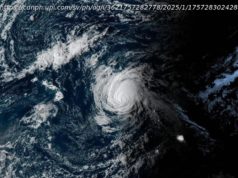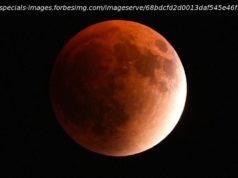The Chinese lost control of the Tiangong-1 space station in 2016. And it’s expected to crash around April 1.
In 2016, China lost control of its space station, a school-bus-size outpost called Tiangong-1. Up until that point, the plan was to bring the out-of-service station back to Earth through a controlled final descent. A few well-timed thruster blasts would have made sure the station landed safely in one of the world’s oceans.
But for reasons China hasn’t fully explained, its first-ever space station malfunctioned. And due to a phenomenon called orbital decay, the empty, rogue space station has been steadily cruising back toward Earth on its own.
Tiangong-1, which means “heavenly palace,” is now about 124 miles above the Earth and is expected to crash into the atmosphere around April 1, give or take a day, the European Space Agency (ESA) reports. It should mostly burn up in the atmosphere as it crashes, but a few heavy, dense pieces may hit the ground.
But again, the descent will not be controlled. The thrusters cannot be turned on. We don’t even know where those pieces are going to land.
On March 26, the ESA released this map marking in green where the space station could conceivably crash. It’s… pretty unspecific.
The area covers much of China, India, the United States, and other densely populated areas. Scandinavia seems safe. The polar bears in the Arctic face many threats, but thankfully, Tiangong-1 is not one of them. Ditto for the penguins in Antarctica.
For what it’s worth, the ESA reports Tiangong-1 is slightly more likely to impact the northern or southern bound of the green-shaded area. The space station spends less time traversing the Earth near the equator than it does these more northern and southern regions. “Only from one day before the actual reentry will it become possible to roughly predict which ground tracks, and hence which regions on Earth, might witness the reentry,” the ESA reports.
The space agency suspects the station will crash on April 1, though there’s some uncertainty in their prediction.
It’s hard to predict exactly when and where the space station will crash. The rate at which Tiangong-1 descends is determined in part by the friction it encounters as it collides with the very top layers of the atmosphere. And the conditions there are hard to measure and hard to model in computer simulations.
That said, the likelihood of being hit by a falling piece of space debris is infinitesimally small — just one in a trillion, according to the nonprofit Aerospace Corporation. “By comparison, the risk of being hit by lightning is one in 1.4 million and the risk that someone in the US will be killed in a hurricane is about one in six million,” it explains. And remember, the space station could very well crash into the ocean or over an uninhabited area, and the pieces could spread out over hundreds of miles.
NOTE: If you or someone you know encounters a piece of Tiangong-1 debris, please contact us (email: brian@vox.com)! We’d love to interview you for a story.
There’s only one person in the history of the Space Age to be hit on the ground by debris from space: Lottie Williams. In 1997, Williams was minding her own business in a Tulsa, Oklahoma, park when a piece of disintegrated rocket hit her on the shoulder. It was just a “glancing blow,” a Wired retrospective reports, “and the debris was relatively light and probably traveling at a low velocity.”
Amazingly, the only recorded instance of a person being struck by a meteorite also occurred in the United States. (“USA! USA!”)
Ann Hodges, a resident of Sylacauga, Alabama, was hit in the stomach by a space rock when one came hurtling through the roof of her house in 1954. She got this huge, nasty bruise. And she survived.
Tiangong-1 will crash onto Earth. But it’s hardly the only uncontrollable piece of metal in orbit around us.
There are more than 22,000 objects larger than 4 inches that could potentially pose a threat to our satellites or spacecraft. There’s an even greater number of tiny objects that go untracked. In all, there may be 160 million plus pieces of space garbage circling the Earth, the ESA finds. Put more simply: The space around Earth is becoming a junkyard.
And because of the speed they travel — best measured in miles per second — they’re also essentially projectiles that can blast holes in and cause damage to our satellites.
And the more space junk, the greater the threat: If these objects destroy other objects in orbit, they make even more debris. Which is concerning, considering that the amount of materials being left behind is growing.
Objects like Tiangong-1 come back down to Earth relatively quickly, within a few years. That’s because the space station is relatively close to the ground, orbiting at 120+ miles. But objects orbiting above 620 miles can be expected to stay in space for centuries. The fear is that one day there might be so much space debris that we will have essentially made it impossible, or very dangerous, for spacecraft to leave our planet at all.
Our colleagues at the Verge have a great list of resources you can use to track when and where Tiangong-1 might fall. Find those here.
You can see Tiangong-1’s current position in orbit here . (Though it won’t say where it is crashing.) The ESA also has a great FAQ on Tiangong-1 on its website, as well as daily updates of its crash-time estimates here and on Twitter. The nonprofit Aerospace Corporation is also tracking the space station; you can find their latest updates here.
And amateur and professional astronomers and space scientist are having a field day with Tiangong-1 with the hashtag #tiangong-1 .
Home
United States
USA — Science A Chinese space station is hurtling toward Earth. Where will it land?






